…of a town or city can be such a good way to understand the history of a place. As a child I found it most instructive in Rome to trace and 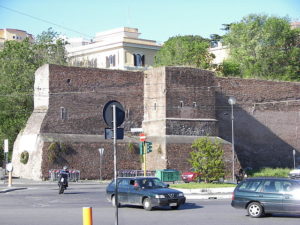 walk alongside not one set of Roman walls but two – the Servian and the Aurelian – and understand, via them, how Rome developed from Republican citadel to imperial capital and then ( if you add in the Vatican walls ) to the Caput Mundi. I have since walked along or beside city walls in many a place, from Berwick to Dubrovnik, from York to Cadiz, as well as ‘border’ walls, like Hadrian’s and Offa’s ( though that was more of a rampart with ditch ). I have also ‘walked the walls’ of both of my current home cities.
walk alongside not one set of Roman walls but two – the Servian and the Aurelian – and understand, via them, how Rome developed from Republican citadel to imperial capital and then ( if you add in the Vatican walls ) to the Caput Mundi. I have since walked along or beside city walls in many a place, from Berwick to Dubrovnik, from York to Cadiz, as well as ‘border’ walls, like Hadrian’s and Offa’s ( though that was more of a rampart with ditch ). I have also ‘walked the walls’ of both of my current home cities.
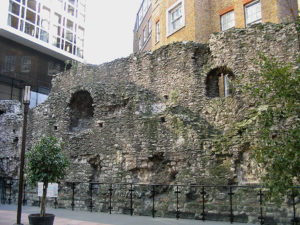
Fragments of London’s walls can still be seen, though at a much lower level than current streets. The original Roman defensive wall, was often augmented and, by the early Middle Ages, it had seven city gates and thirteen water gates. Today the former are commemorated in street names, from Ludgate in the west to Aldgate in the east. The street named London Wall runs, roughly, along a northern section of the wall and Houndsditch in East London signifies the old moat of the eastern section of the wall (a place to dispose of one’s dead dogs).
The walls of Jerez are still, largely extant and, though they have disappeared within or under later buildings in 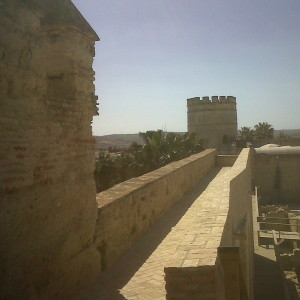 some stretches, it is possible to see them as a whole with gaps, rather than as examples of surviving fragments. It is also possible to walk atop them, at least those elements which comprise the outer walls of the Alcazar at the highest point of the city in both its modern and ancient incarnations. These walls are, mainly 12th century Almohad constructions, though the excavations within the castle reveal the earlier Ummayad originals, probably going back three centuries more.
some stretches, it is possible to see them as a whole with gaps, rather than as examples of surviving fragments. It is also possible to walk atop them, at least those elements which comprise the outer walls of the Alcazar at the highest point of the city in both its modern and ancient incarnations. These walls are, mainly 12th century Almohad constructions, though the excavations within the castle reveal the earlier Ummayad originals, probably going back three centuries more.
The Alcazar is the place to begin a walk around the walls. I like to go clockwise (being in the northern hemisphere) and, once you leave the Alcazar, this means taking the route on trust for a short time, as you walk down the hill, passed the Cathedral and (turn left when you get to the valley floor ) to the Rota Gate. The Gate itself is 18th century, but it 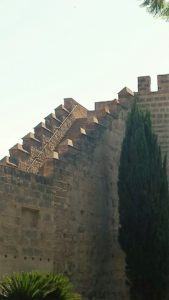 sits within the earlier walls, which then stretch into what is now Bodega Fundador or Domecq. So it’s back to a thin little street Calle Espiritu Santo, which rises steeply up the hill opposite the Cathedral, past the rounded contours of the Convent of that name, into Calle San Idelfonso. With the formal Domecq House on your left, continue along until you turn into Calle San Blas on the right. The corner of this street contains a ruined palace which I have coveted for many years, mainly because of its, now overgrown, garden.
sits within the earlier walls, which then stretch into what is now Bodega Fundador or Domecq. So it’s back to a thin little street Calle Espiritu Santo, which rises steeply up the hill opposite the Cathedral, past the rounded contours of the Convent of that name, into Calle San Idelfonso. With the formal Domecq House on your left, continue along until you turn into Calle San Blas on the right. The corner of this street contains a ruined palace which I have coveted for many years, mainly because of its, now overgrown, garden.
Swing left into Plaza Mercado, the old Arab market place. Half way up on the left is the Alfonsine church of San Mateo. Take the road which runs beside it until you find yourself out on the city ring road. Turn right and walk up to the traffic roundabout at the top of the hill. From here you will see the ancient walls again as they proceed along Calle Mura (Wall Street) their lower reaches obscured by bodega buildings, but their crenellations clearly visible. Follow them.
The whole walls can be seen as you pass Santiago into Calle Ancha, with monuments to various explorers, including the discoverer of Florida, Juan Ponce de Leon. Soon you will reach the major traffic crossroads with Calle Porvera, which is where the walls turn right. They follow the line of this street, though are often absorbed into private dwelling houses and 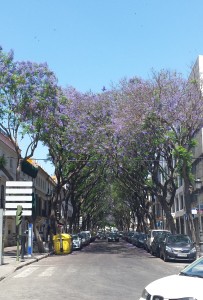 only their tops are visible. A major bastion is visible at Calle Puerta Nueva (New Gate Street). Continue along Porvera, though the walls are now pulling slightly away to your right and cross the small street of Torneria into the Calle Larga.
only their tops are visible. A major bastion is visible at Calle Puerta Nueva (New Gate Street). Continue along Porvera, though the walls are now pulling slightly away to your right and cross the small street of Torneria into the Calle Larga.
On the right, almost opposite the Parking sign is an alleyway with steps not far along. These go upwards into the back garden of Hotel Palacio Garvey and it is here that you can see the old Sevilla Gate amidst the walls, which form part of the hotel’s garden. Retrace your steps and, not much further along Calle Large is the Bar Moderna, the back walls of which are actually the old city walls. You are entering the, relatively, modern shopping area now ( just one or two 17th century palaces converted into shops ) and you don’t pick up the walls again until Calle Consistorio which leads off to the right from the main square at Arenal, which you will see ahead of you as you head down the Larga. There you can see towers and walls, behind and part of the ice cream parlour and also in the restaurant A Mar in Calle Latorre ( turn left off Consistorio) and in 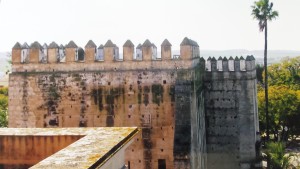 the Calle Pescadaria Vieja which is nearby.
the Calle Pescadaria Vieja which is nearby.
Walking along this tiny street, which is full of tapas bars, you can see more walls and you exit through a low arch in them into Arenal. Turn right to find yourself back at the Alcazar. The walk takes about an hour and a half if you step out, up to three or four if you amble, digress and generally look about you. I always prefer to do the latter.
If you enjoyed reading about this walk you might also enjoy Arcos de la Frontera Grazalema Benamahoma to El Bosque Cadiz in the Rain Jerez in the Rain Journey through the pinsapar


 RSS – Posts
RSS – Posts
2 responses to “Walking the walls….”